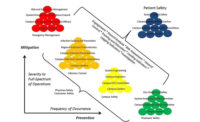In an effort to save money, Flint, Michigan in 2014 switched the source of its public water supply from the Detroit River to the less expensive Flint River. The cascade of generally well-known catastrophic events associated with lead exposure continue to unfold.
Settlement of civil lawsuits against various parties exceeds $626 million. Michigan alone spent $53 million on direct defense costs. An economist for plaintiffs in an ongoing case against two consulting firms testified that monetary damage for lost income for each child that drank lead contaminated Flint water range from $3 million to $8.5 million. Additional damages are necessary for “mental anguish, loss of social pleasures and enjoyments, embarrassment and humiliation.”
Failure in risk decisions
Among the top risk decision failures in the Flint crisis is that many people did not fully consider where lead is present, how it can be released and the consequences of the release.
Do not fall for lead is not a concern because:
- Amount of lead at the workplace does not trigger threshold quantity for EPA TRI Form R reporting;
- SDS for products that may contain lead, do not report lead (0.1% by weight is lowest required reporting per OSHA HazCom);
- Purchased products, such as plumbing fixtures, are labelled “lead-free;” or,
- Air sampling for lead found results below OSHA “action limits.”
- If any part of the worksite infrastructure is older than 1978 then lead may be present in old paint. Machining on steel products may release lead. These are just a couple of numerous examples.
Problematic concerns
Because of the Flint lead crisis, MIOSHA updated their occupational lead standard in December 2018. Appendix A to the standard included the advisory information: “The blood lead level (BLL) for female workers who are pregnant should be maintained below 5 ug/dL at all times to prevent adverse health effects to the developing fetus.” MIOSHA left the PEL to lead at 50 ug/m3 unchanged.
Federal OSHA’s Advanced Notice of Proposed Rulemaking (ANPRM) for BLLs closed for public comments on August 29, 2022. ANPRM set the stage for a final lead rule. OSHA’s ANPRM included questions such as, “Should OSHA consider reducing its PEL of 50 ug/m3 for occupational lead exposure?”
There are two highly problematic concerns above. Can you identify these concerns and how they must be navigated to limit risk?
Risk decisions
Pregnant workers, or workers considering pregnancy, should not be encouraged by the employer to have a BLL test. Why? Lead is stored in bone and will released into the worker’s blood, and then into fetal blood, during pregnancy. BLL measured during pregnancy will show a lifetime of lead exposure that maybe totally unrelated to your workplace. Let the worker’s physician determine if a BLL test for pregnancy is needed.
Measure airborne exposure (either personal or area) to lead using modified NIOSH #7301 method. Sample to reach the LOD at 0.1 ug/m3. Why? A key reason is that this action establishes due diligence in the event of a lead exposure tort claim.
Inform stakeholders e.g., any worker exposed to any amount of lead of the results of airborne sampling for lead. Be aware, this may be a requirement of OSHA 1910.1020 employee access to exposure and medical records.
Conform through policy and procedure to a company established occupational exposure limit (OEL) for lead and its inorganic compounds well below common U.S. guidelines. Why? Federal OSHA PEL, ACGIH TLV, and NIOSH REL for lead at 50 ug/m3 8-hr. TWA are way out-of-date. The OSHA PEL and NIOSH REL for lead were established over 40 years ago. The ACGIH last updated its TLV for lead in 1995. A lower OEL than common guidelines will demonstrate good faith and responsible actions by the business.
What should the OEL for lead be? A conformance OEL for lead must be an internal decision based upon various factors such as feasibility. The European Chemicals Agency (ECHA) adopted an opinion in 2020 from its Committee for Risk Assessment (RAC), that the scientific OEL for lead and its inorganic compounds as an 8-hour TWA is 4 ug/m3 (inhalable fraction). Risk science considered by RAC included California Environmental Protection Agency’s “extensive modelling exercise” that determined the OEL for lead should be at 2.1 ug/m3 in order to prevent BLL exceeding 10 ug/dL.
Acknowledge “at risk” populations. The June 2022 overturn of Roe v Wade by the U.S. Supreme Court spawned numerous state “personhood laws” (see last month’s column). ECHA’s scientific opinion on the OEL for lead includes the caveat that the air limit value of 4 ug/m3 for lead and its inorganic compounds “does not protect offspring of women of childbearing age.” If lead is below the LOD with modified NIOSH #7301 method, then there is limited or no concern for at risk populations.
Engage a CIH® to support risk decisions. A CIH® is needed for many reasons. ECHA advises that an “occupational hygiene expert” should follow-up whenever a country blood level reference value (BLRV) is exceeded. A CIH® can explain how and why BLRVs are created and applied. For example, a BLRV is not a toxicity value and is not an OEL. In October 2021, the U.S. CDC lowered our nation’s BLRV from 5 ug/dL to 3.5 ug/dL. In April 2022, the Michigan Department of Health and Human Services published an announcement about the lower BLRV, with a heading “Lower level will expand services to more Michigan families.”
Lead success
The BLL among the U.S. population has declined from a geometric mean at 12.8 ug/dL in 1976 to 0.82 ug/dL today, nearly 95% decline. Success may be attributed to various laws and practices to restrict and control lead exposure that began in earnest during the early 1970s. Primarily because the CDC and other authorities have not identified a safe level of lead to children e.g., very low amounts may cause brain damage, strict efforts must be taken to protect this “at risk” population.
It is imperative that employers and OHS pros learn from Flint MI catastrophic mistakes with lead risk management. Among various risk decisions, OHS pros must differentiate between compliance vs. conformance, workers’ compensation vs. tort liability, and the contentious issue of when “children” may be associated with workplace exposures.




